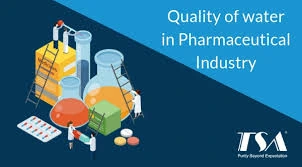Water is a key element for numerous pharmaceutical and life sciences processes. As a raw material, water is used in processing, formulation and manufacturing various pharmaceutical products and active pharmaceutical ingredients (API). Most industries rely majorly on surface water and groundwater sources for their pharmaceutical purposes. In its natural state, water from these sources is not free from contamination and needs to be purified before industries use it for pharmaceutical purposes.
This process of water purification involves distillation and deionization that reduces the concentration of contaminated particles, parasites, bacteria, algae, viruses, and fungi. It is imperative that water is treated using proper procedures to ensure its purity.
Depending on the route of administration of the pharmaceutical product, different pharmaceutical water systems quality are required. Based on water quality, below are different types of water used for pharmaceutical purposes.
Drinking Water
Drinking water can be best described as Potable water. It may be sourced from a public water utility, a private water supply (e.g., a well) or a combination of both. Drinking water is the minimum quality of water that ought to be used for the preparation of official substances and other bulk pharmaceutical substances. The treatment required to make it safe for human consumption is determined post evaluating the condition of the source water. Drinking water, free from contamination is used for cleaning pharmaceutical manufacturing equipment and product-contact components. Some common methods of treatment include desalinization, softening, deionization, particle reduction, and reduction of inorganic and/or organic materials.
The equipment and systems used to produce drinking water, their storage tanks, distribution pipeworks and the water quality itself need to be routinely monitored for environmental, seasonal or supply changes which may affect the integrity of the water systems in place. Additionally, techniques such as backflushing, chemical and /or thermal sanitization should be put in place to tackle the recontamination of water.
Purified Water
Purified water is used mainly as an excipient in the production of non-parenteral administrations and in other pharmaceutical applications. Non-parenteral is most commonly referred to as the route that oral medications are administered, therefore it is of utmost importance that water used for non-parenteral preparations must meet the requirements for ionic and organic chemical purity.
Purified water is generally produced by ion exchange, reverse osmosis, and ultrafiltration. While producing purified water it is important to protect it from recontamination and other microbial protection.
Highly Purified Water (HPW)
Highly Purified Water or HPW is a unique specification for water found only in the European Pharmacopoeia
The European Pharmacopoeia has a unique specification for water called highly purified water (HPW). For preparing, HPW drinking water should be used as a minimum quality water source. HPW must satisfy the same quality standard as Water for Injections (WFI) however, the water treatment process may be different.
HPW can be processed by a mixture of different practices such as RO, ultrafiltration and deionization. Needless to say, highly purified water should be protected from recontamination and microbial proliferation.
Water for Injections (WFI)
Water for Injections or WFI is majorly used as an excipient in manufacturing parenteral and other pharmaceutical preparations where endotoxin must be controlled. WFI should be prepared with drinking water or purified water as a minimum quality feed water.
Chemical purity in WFI poses a major problem for pharmaceutical manufacturers. The microbiological quality of the water needs to be consistent in testing and should comply with the requirements for bacterial endotoxins being not more than 0.25 IU of endotoxin per ml. The only dependable process of producing reliable WFI is multi-effect distillation. It remains unchallenged as the only official method for producing WFI.
WFI in itself is not sterile and is an intermediate bulk product that is best suited to be used as an ingredient during the formulation of other pharmaceutical products. Hence, WFI should also be protected from recontamination and microbial proliferation.
As stated above, maintaining water quality is a crucial practice for all companies involved in manufacturing or processing pharmaceutical substances. Right from determining the quality of the water source to choosing a suitable treatment method to purify it, water systems need to be designed and operated under proper regulatory guidelines. Therefore it is vital that you make the right decision and choose a certified water treatment plant manufacturer that has a proven track record of helping its partners. Associating with the right water treatment plant manufacturers can help your business achieve all your purity optimization needs; eliminating physical, chemical and microbiological impurities.






